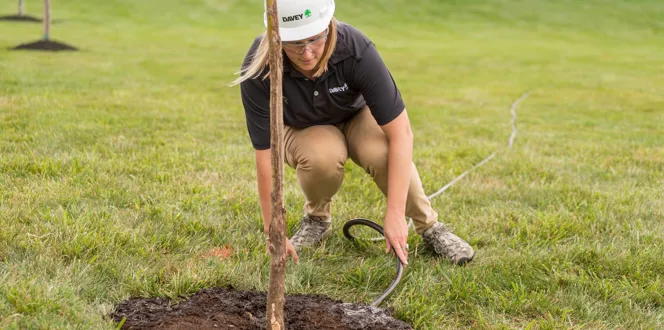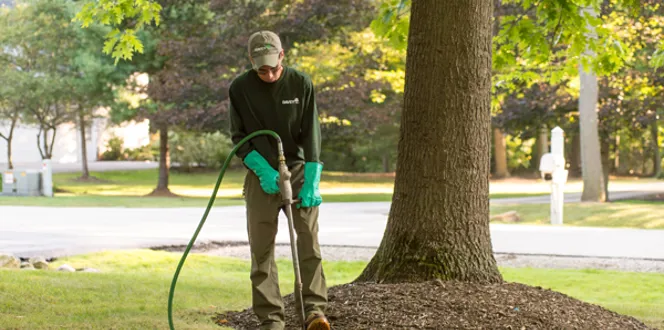Fire damage is certainly not something you want to have to go through with your beloved landscape trees.
But in some areas where drought, dry conditions, and winds make fires more likely, this is a very real occurrence homeowners find themselves having to deal with.
Various levels of fires can harm your trees to different degrees based on their intensity and severity – from crown to understory to surface fires.
Let’s talk about the proper measures you can take on how to treat fire-damaged trees.
Will Trees Recover From Fire?
After a fire, one of your biggest questions likely involves what can help trees to survive fires.
Whether or not a tree will recover depends on the damage type, burn intensity, fire duration, and length of dehydration. Add to these factors the tree type, age , and time of year, too.
For instance, fire-adapted species, such as ponderosa pine, bur oak, and longleaf pine, are more resilient to understory and surface fires. Also, younger trees or those just coming out of winter dormancy in spring can suffer more severe damage compared to those that experienced late or dormant season fires.
Fires can damage your trees in multiple ways, including:
- Leaf or needle scorch
- Trunk or branch damage
- Bud health
- Cambium (inner tissue) injury girdling the stem
- Root damage
- Hydrophobic soils (preventing water absorption) with lost organic matter
How To Care For Fire-Damaged Trees
There are some immediate steps you can take when it comes to how you can help restore burned trees and get your tree back to better health. If your tree has live buds throughout much of its crown and living cambium most of the way around the stem, it has a chance of survival.
Watering
The first thing you should do with fire-damaged trees is to water them.
Your tree’s soil is likely dried out or even hydrophobic from the fire, so watering will help. Water slowly by laying a drip or soaker hose on the ground and letting it run in a slow and steady fashion. Soak the entire area under the tree’s canopy – from the trunk out to the branch tips.
Dig down to make sure the soil is absorbing the water. If it’s not, using a wetting agent and raking the ground to loosen the impermeable layer can help. If organic matter has been burned from the soil in the fire, add an inch of compost when raking the surface. Then mulch around the tree with a thin layer of weed-free straw or tree-based double-grounded mulch after raking to aid in water absorption and retention.
If you’re watering trees in drought conditions or in an area with water restrictions, a technique like deep root (slow) watering uses less water. Plus, slow watering is the way to go if you want to reduce an expensive water bill.
Post-Damage Tree Pruning
Another part of tree care after a wildfire is removing dead or hazardous branches. These dead and burned limbs can be dangerous and removing them with proper cuts to the outside of your tree’s branch collar is important. If tree trimming, in this case, seems challenging or you don’t know how to do this properly, your local certified arborist can help.
Most deciduous trees can sprout new growth where lost branches were, but most conifers, with some exceptions such as pitch pine, will not regrow lower trunk branches.
Fertilization
After you’ve determined that your soil is well hydrated, fertilization with a slow-release fertilizer can be beneficial in how you can help restore burned trees.
A good fertilizer helps replace nutrients lost as a result of the burned organic matter that took place during the fire.
Pest Prevention
Weak and stressed trees are always more susceptible to insect attacks, and fire-damaged trees are no exception.
If you have trees you value that have suffered scorching but are likely to recover, preventively treating them for boring insects is very important to their survival as they re-establish.
Protection
For trees that have burned bark, you can wrap the trunks and any major limbs in light-colored cloth, cardboard, or tree wrap for up to a year to prevent sunburn.
To prevent fire damage in the future, focus on what can help trees survive fires.
First, chip or remove dead trees and limbs from your landscape to remove that potential fire fuel. Remove lower limbs to prevent fires from spreading into the canopy. Mow shrubs and tall grasses back regularly. Plant fire-tolerant species. Then, design your landscape by keeping fire resiliency in mind, which provides nearby structures with 50 feet or more of defensible space, and establishes permanent firebreaks, escape routes, safety zones, and water sources for firefighting.







